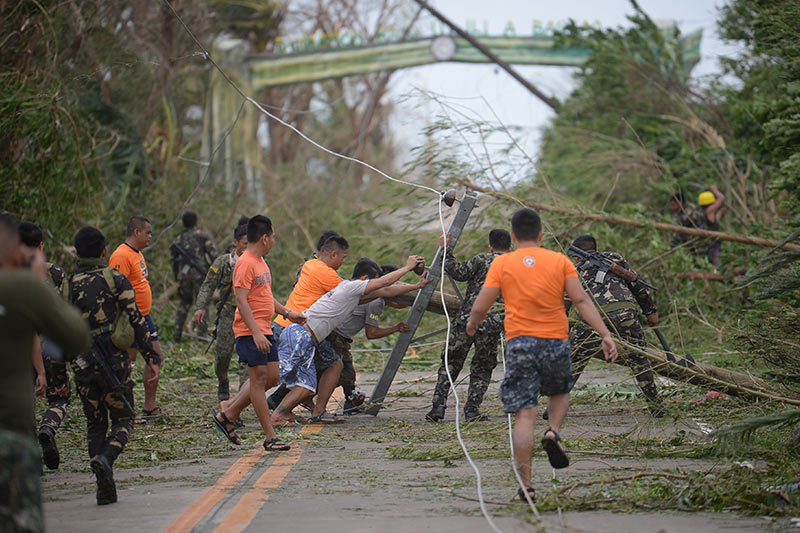By: (philstar.com) - September 16, 2018 - 7:35am
MANILA, Philippines — Typhoon Ompong barrels towards densely populated Hong Kong and southern China, hours after it left the Philippine area of responsibility at 9 p.m. on Saturday, PAGASA said, as it warned of monsoon rains.
In its 23rd and final severe weather bulletin on "Ompong" at 5 a.m. Sunday, PAGASA said the eye of the typhoon, the strongest to hit the country this year, was located at 570 km west of Basco, Batanes at 4 a.m. today.
"Ompong" was packing maximum sustained winds of 145 kph near the center and gustiness of up to 180 kph. It moves at a west-northwest direction at 25 kph.
All tropical cyclone warning signals were lifted by PAGASA.
PAGASA weather forecaster Ariel Rojas said Saturday that even though the storm had passed the Philippines, it would continue to bring heavy rain in the country possibly causing more floods and landslides until Monday.
On Sunday, PAGASA said the southwest monsoon or "habagat" enhanced by "Ompong" would bring occasional gusty winds and scattered light to moderate to at times heavy rains over Western Visayas, Mimaropa, Ilocos Region, Batangas, Bataan and Zambales.
Fisherfolk and those with small seacrafts were also advised not to venture out over the northern and western seaboards of Luzon.
At least 8 dead
"Ompong" has smashed through the Philippines, as the biggest storm to hit the region this year claimed the lives of its first victims and forced tens of thousands to flee their homes.
Roughly four million people—a quarter of whom live on a few dollars a day—were in the path of destruction that the storm slashed through the northern tip of Luzon island on Saturday, leaving at least eight dead.
"As we go forward, this number will go higher," Ricardo Jalad, head of the Office of Civil Defense, told reporters Saturday, referring to the death toll.
The dead were six people killed in landslides, a girl who drowned and a security guard crushed by a falling wall. In addition to the eight killed in the Philippines, a woman was swept out to sea in Taiwan.
As the powerful storm left the Philippines, authorities began sending search teams to remote areas hit by communication and power outages.
In the northern town of Baggao, the storm had collapsed houses, torn off roofs and downed power lines. Shell-shocked villagers could be seen picking through the debris from their homes.
But the full extent of the storm's destruction was only beginning to be known, with reports of dozens of rain-soaked hillsides collapsing, torrents of out-of-control floodwaters and people being rescued from inundated homes.
More than 105,000 people fled their homes in the largely rural agricultural region, which is one of the nation's top producers of corn and rice.
An average of 20 typhoons and storms lash the Philippines each year, killing hundreds of people and leaving millions in near-perpetual poverty.

Rescue workers clear a road of debris and toppled electric posts caused by strong winds due to Typhoon Ompong as they try to reach Baggao town in Cagayan province, north of Manila September 15, 2018.
Ted Aljibe/AFP
'End of the world'
"Among all the typhoons this year, this one (Mangkhut) is the strongest," Japan Meteorological Agency forecaster Hiroshi Ishihara told AFP on Friday.
"This is a violent typhoon. It has the strongest sustained wind (among the typhoons of this year)."
Survivors were traumatized by the confrontation with the monster storm.
"It felt like the end of the world... that was stronger than Lawin", said Bebeth Saquing, 64, using the local name for Super Typhoon Haima, which was one of the most powerful storms of 2016.
"I did not sleep," she told AFP by phone from her home, which stood up to "Ompong's" pounding.
As the storm is on pace to hit China's southern coast on Sunday, Cathay Pacific warned travelers that it expected more than 400 flight cancellations over the next three days.
Philippine government forecaster Ariel Rojas said that, even though the storm had passed the Philippines, it would continue to bring heavy rain in the country, possibly causing more floods and landslides until Monday.
But the storm was unlikely to get any stronger, Rojas said.
"It could likely maintain its current intensity or even weaken," he told AFP.
The Hong Kong government said "Mangkhut" would pose "a severe threat to the region." Many residents in the city and neighboring Macau stocked up on food and supplies.
Volunteers also helped residents of low-lying Hong Kong fishing village Tai O hoist their furniture and appliances to higher ground.
The president of Taiwan, Tsai Ing-wen, told citizens to be ready as powerful waves pounded the shore.
"The typhoon is powerful and even (if) it's not expected to make a landfall in Taiwan, we should be well prepared and not... take it lightly," she wrote on Facebook.
— with Agence France-Presse

No comments:
Post a Comment